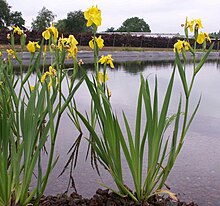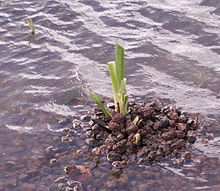Organisms
Saprophytic bacteria and fungi can convert organic matter into living cell mass, carbon dioxide, water and a range of metabolic by-products. These saprophytic organisms may then be predated upon by protozoa, rotifers and, in cleaner waters, Bryozoa which consume suspended organic particles including viruses and pathogenic bacteria. Clarity of the water may begin to improve as the protozoa are subsequently consumed by rotifers and cladocera. [4] Purifying bacteria, protozoa, and rotifers must either be mixed throughout the water or have the water circulated past them to be effective. Sewage treatment plants mix these organisms as activated sludge or circulate water past organisms living on trickling filters or rotating biological contactors. [5]
Aquatic vegetation may provide similar surface habitat for purifying bacteria, protozoa, and rotifers in a pond or marsh setting; although water circulation is often less effective. Plants and algae have the additional advantage of removing nutrients from the water; but some of those nutrients will be returned to the water when the plants die unless the plants are removed from the water. Because of the complex chemistry of Phosphorus much of this element is in an unavailable form unless decomposition creates anoxic conditions which render the phosphorus available for re-uptake. Plants also provide shade, a refuge for fish, and oxygen for aerobic bacteria. In addition, fish can limit pests such as mosquitoes. Fish and waterfowl feces return waste to the water, and their feeding habits may increase turbidity. Cyanobacteria have the disadvantageous ability to add nutrients from the air to the water being purified and to generate toxins in some cases.
The choice of organism depends on the local climate different species and other factors. Indigenous species usually tend to be better adapted to the local environment.
Fish
Fish are frequently the top level predators in a managed treatment eco-system and in some case may simply be a mono-culture of herbivorous species. Management of multi-species fisheries requires careful management and may involve a range of fish species including bottom-feeders and predatory species to limit population growth of the herbivorous fish.
Rotifers
Rotifers are microscopic complex organisms and are filter feeders removing fine particulate matter from water. They occur naturally in aerobic lagoons, activated sludge processes, in trickling filters and in final settlement tanks and are a significant factor in removing suspended bacterial cells and algae from the water column. [6] [7]
Annelids
Annelid worms are essential to the effective operation of trickling filters [8] helping to remove excess bio-mass and enhancing natural sloughing of the bio-film. Supernumerary worms are very commonly found in the drainage troughs around trickling filters and in the final settlement sludge. Annelids also play a key role in lagoon treatment systems and in the effective working or engineered wet-lands. In this environment worms are a principal force in mixing in the upper few centimetres of the sediment layer exposing organic material to both oxidative and anoxic environments aiding the complete breakdown of most organics. They are also a key ingredient in the food-chain transferring energy upwards to fish and aquatic birds.
Protozoa
The range of protozoan species found is very wide but may include species of the following genera:

Water purification is the process of removing undesirable chemicals, biological contaminants, suspended solids, and gases from water. The goal is to produce water that is fit for specific purposes. Most water is purified and disinfected for human consumption, but water purification may also be carried out for a variety of other purposes, including medical, pharmacological, chemical, and industrial applications. The history of water purification includes a wide variety of methods. The methods used include physical processes such as filtration, sedimentation, and distillation; biological processes such as slow sand filters or biologically active carbon; chemical processes such as flocculation and chlorination; and the use of electromagnetic radiation such as ultraviolet light.

Wastewater treatment is a process which removes and eliminates contaminants from wastewater and converts this into an effluent that can be returned to the water cycle. Once returned to the water cycle, the effluent creates an acceptable impact on the environment or is reused for various purposes. The treatment process takes place in a wastewater treatment plant. There are several kinds of wastewater which are treated at the appropriate type of wastewater treatment plant. For domestic wastewater, the treatment plant is called a Sewage Treatment. For industrial wastewater, treatment either takes place in a separate Industrial wastewater treatment, or in a sewage treatment plant. Further types of wastewater treatment plants include Agricultural wastewater treatment and leachate treatment plants.

Biosolids are solid organic matter recovered from a sewage treatment process and used as fertilizer. In the past, it was common for farmers to use animal manure to improve their soil fertility. In the 1920s, the farming community began also to use sewage sludge from local wastewater treatment plants. Scientific research over many years has confirmed that these biosolids contain similar nutrients to those in animal manures. Biosolids that are used as fertilizer in farming are usually treated to help to prevent disease-causing pathogens from spreading to the public. Some sewage sludge can not qualify as biosolids due to persistent, bioaccumulative and toxic chemicals, radionuclides, and heavy metals at levels sufficient to contaminate soil and water when applied to land.
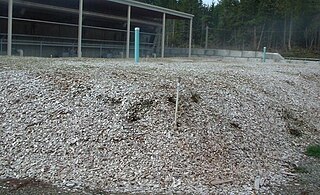
Biofiltration is a pollution control technique using a bioreactor containing living material to capture and biologically degrade pollutants. Common uses include processing waste water, capturing harmful chemicals or silt from surface runoff, and microbiotic oxidation of contaminants in air. Industrial biofiltration can be classified as the process of utilizing biological oxidation to remove volatile organic compounds, odors, and hydrocarbons.

A constructed wetland is an artificial wetland to treat sewage, greywater, stormwater runoff or industrial wastewater. It may also be designed for land reclamation after mining, or as a mitigation step for natural areas lost to land development. Constructed wetlands are engineered systems that use the natural functions of vegetation, soil, and organisms to provide secondary treatment to wastewater. The design of the constructed wetland has to be adjusted according to the type of wastewater to be treated. Constructed wetlands have been used in both centralized and decentralized wastewater systems. Primary treatment is recommended when there is a large amount of suspended solids or soluble organic matter.

Waste stabilization ponds are ponds designed and built for wastewater treatment to reduce the organic content and remove pathogens from wastewater. They are man-made depressions confined by earthen structures. Wastewater or "influent" enters on one side of the waste stabilization pond and exits on the other side as "effluent", after spending several days in the pond, during which treatment processes take place.

The activated sludgeprocess is a type of biological wastewater treatment process for treating sewage or industrial wastewaters using aeration and a biological floc composed of bacteria and protozoa. It uses air and microorganisms to biologically oxidize organic pollutants, producing a waste sludge containing the oxidized material.
BioHome was a small facility created by NASA in the late 1980s that could support one person in a fully functional habitat. One of the influences on the project was the results from data obtained on the 1973 Skylab 3 (SL-3), where a total of 107 VOCs were offgassed by synthetic materials that composed the SL-3. However, the study of indoor air quality was not the only focus of the project, as it was a part of research into closed ecological life support systems.

Wastewater quality indicators are laboratory test methodologies to assess suitability of wastewater for disposal, treatment or reuse. The main parameters in sewage that are measured to assess the sewage strength or quality as well as treatment options include: solids, indicators of organic matter, nitrogen, phosphorus, indicators of fecal contamination. Tests selected vary with the intended use or discharge location. Tests can measure physical, chemical, and biological characteristics of the wastewater. Physical characteristics include temperature and solids. Chemical characteristics include pH value, dissolved oxygen concentrations, biochemical oxygen demand (BOD) and chemical oxygen demand (COD), nitrogen, phosphorus, chlorine. Biological characteristics are determined with bioassays and aquatic toxicology tests.

Sewage farms use sewage for irrigation and fertilizing agricultural land. The practice is common in warm, arid climates where irrigation is valuable while sources of fresh water are scarce. Suspended solids may be converted to humus by microbes and bacteria in order to supply nitrogen, phosphorus and other plant nutrients for crop growth. Many industrialized nations use conventional sewage treatment plants nowadays instead of sewage farms. These reduce vector and odor problems; but sewage farming remains a low-cost option for some developing countries. Sewage farming should not be confused with sewage disposal through infiltration basins or subsurface drains.

Secondary treatment is the removal of biodegradable organic matter from sewage or similar kinds of wastewater. The aim is to achieve a certain degree of effluent quality in a sewage treatment plant suitable for the intended disposal or reuse option. A "primary treatment" step often precedes secondary treatment, whereby physical phase separation is used to remove settleable solids. During secondary treatment, biological processes are used to remove dissolved and suspended organic matter measured as biochemical oxygen demand (BOD). These processes are performed by microorganisms in a managed aerobic or anaerobic process depending on the treatment technology. Bacteria and protozoa consume biodegradable soluble organic contaminants while reproducing to form cells of biological solids. Secondary treatment is widely used in sewage treatment and is also applicable to many agricultural and industrial wastewaters.

Sewage sludge treatment describes the processes used to manage and dispose of sewage sludge produced during sewage treatment. Sludge treatment is focused on reducing sludge weight and volume to reduce transportation and disposal costs, and on reducing potential health risks of disposal options. Water removal is the primary means of weight and volume reduction, while pathogen destruction is frequently accomplished through heating during thermophilic digestion, composting, or incineration. The choice of a sludge treatment method depends on the volume of sludge generated, and comparison of treatment costs required for available disposal options. Air-drying and composting may be attractive to rural communities, while limited land availability may make aerobic digestion and mechanical dewatering preferable for cities, and economies of scale may encourage energy recovery alternatives in metropolitan areas.

A trickling filter is a type of wastewater treatment system. It consists of a fixed bed of rocks, coke, gravel, slag, polyurethane foam, sphagnum peat moss, ceramic, or plastic media over which sewage or other wastewater flows downward and causes a layer of microbial slime (biofilm) to grow, covering the bed of media. Aerobic conditions are maintained by splashing, diffusion, and either by forced-air flowing through the bed or natural convection of air if the filter medium is porous. The treatment of sewage or other wastewater with trickling filters is among the oldest and most well characterized treatment technologies.
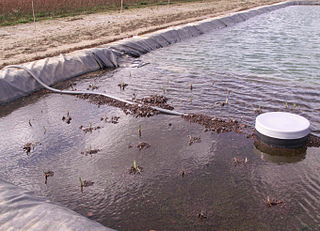
A lava filter is a biological filter that uses lavastone pebbles as support material on which microorganisms can grow in a thin biofilm. This community of microorganisms, known as the periphyton break down the odor components in the air, such as hydrogen sulfide. The biodegradation processes that occurs is provided by the bacteria themselves. In order for this to work, sufficient oxygen as well as water and nutrients is to be supplied.

Sewage treatment is a type of wastewater treatment which aims to remove contaminants from sewage to produce an effluent that is suitable to discharge to the surrounding environment or an intended reuse application, thereby preventing water pollution from raw sewage discharges. Sewage contains wastewater from households and businesses and possibly pre-treated industrial wastewater. There are a high number of sewage treatment processes to choose from. These can range from decentralized systems to large centralized systems involving a network of pipes and pump stations which convey the sewage to a treatment plant. For cities that have a combined sewer, the sewers will also carry urban runoff (stormwater) to the sewage treatment plant. Sewage treatment often involves two main stages, called primary and secondary treatment, while advanced treatment also incorporates a tertiary treatment stage with polishing processes and nutrient removal. Secondary treatment can reduce organic matter from sewage, using aerobic or anaerobic biological processes. A so-called quarternary treatment step can also be added for the removal of organic micropollutants, such as pharmaceuticals. This has been implemented in full-scale for example in Sweden.

River Bank filtration is a type of filtration that works by passing water to be purified for use as drinking water through the banks of a river or lake. It is then drawn off by extraction wells some distance away from the water body. The process may directly yield drinkable water, or be a relatively uncomplicated way of pre-treating water for further purification.

Sewage is a type of wastewater that is produced by a community of people. It is typically transported through a sewer system. Sewage consists of wastewater discharged from residences and from commercial, institutional and public facilities that exist in the locality. Sub-types of sewage are greywater and blackwater. Sewage also contains soaps and detergents. Food waste may be present from dishwashing, and food quantities may be increased where garbage disposal units are used. In regions where toilet paper is used rather than bidets, that paper is also added to the sewage. Sewage contains macro-pollutants and micro-pollutants, and may also incorporate some municipal solid waste and pollutants from industrial wastewater.
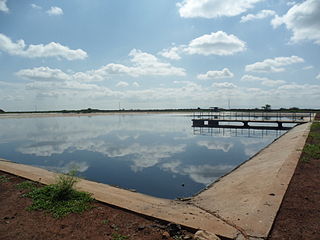
Facultative lagoons are a type of waste stabilization pond used for biological treatment of industrial and domestic wastewater. Sewage or organic waste from food or fiber processing may be catabolized in a system of constructed ponds where adequate space is available to provide an average waste retention time exceeding a month. A series of ponds prevents mixing of untreated waste with treated wastewater and allows better control of waste residence time for uniform treatment efficiency.

A vermifilter is an aerobic treatment system, consisting of a biological reactor containing media that filters organic material from wastewater. The media also provides a habitat for aerobic bacteria and composting earthworms that purify the wastewater by removing pathogens and oxygen demand. The "trickling action" of the wastewater through the media dissolves oxygen into the wastewater, ensuring the treatment environment is aerobic for rapid decomposition of organic substances.
In 2015, 251 million tubes of toothpaste were sold in the United States. A single tube holds roughly 170 grams of toothpaste, so approximately 43 kilotonnes of toothpaste get washed into the water systems annually. Toothpaste contains silver nanoparticles, also known as nanosilver or AgNPs, among other compounds.
